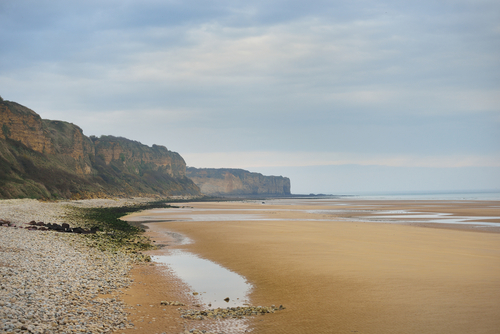Hanging in the Balance – Commemorating D-Day's 80th Anniversary
 Fred Borch is a lawyer and historian. He was Professor of Legal History and Leadership for 18 years at The Judge Advocate General's Legal Center and School located at the University of Virginia. He served 25 years in the Army as a uniformed attorney. After retiring from active duty, Fred took a job in the U.S. Government as the only career historian whose focus was exclusively on military legal history. He has seven degrees, including an M.A. in history from the University of Virginia.
Fred Borch is a lawyer and historian. He was Professor of Legal History and Leadership for 18 years at The Judge Advocate General's Legal Center and School located at the University of Virginia. He served 25 years in the Army as a uniformed attorney. After retiring from active duty, Fred took a job in the U.S. Government as the only career historian whose focus was exclusively on military legal history. He has seven degrees, including an M.A. in history from the University of Virginia.
Eighty years ago today—on June 6, 1944—the unprecedented invasion of Nazi-occupied Europe began when American, British, and Canadian troops waded ashore in Normandy. It was the beginning of the end for the Third Reich, as once the Allies gained a foothold in France, their advantages in men and materiel meant that the days of Hitler’s regime were numbered.
“Overlord” was the codename for the invasion of Europe. The Allies had amassed an Army of 45 divisions, 6,000 airplanes, and 5,300 ships under the command of General Dwight D. Eisenhower. (By comparison, the U.S. Army today has ten active divisions, the U.S. Air Force has 5,500 aircraft, and the U.S. Navy has 475 ships.)
 Opposing the Allies were over 50 German divisions, ten of them tank units. Field Marshal Erwin Rommel, commanding 40 of these divisions, spent the time before the invasion strengthening his defenses. For the Germans, who laid over five million mines, the question was not if the invasion was coming but when and where. As for the Allies, they had the same questions. Because of the limited range of Allied fighter aircraft—needed for close air support of any invasion force—the landings had to occur between the Pas de Calais and Normandy. The Allies finally decided on Normandy because of its relatively weaker defenses.
Opposing the Allies were over 50 German divisions, ten of them tank units. Field Marshal Erwin Rommel, commanding 40 of these divisions, spent the time before the invasion strengthening his defenses. For the Germans, who laid over five million mines, the question was not if the invasion was coming but when and where. As for the Allies, they had the same questions. Because of the limited range of Allied fighter aircraft—needed for close air support of any invasion force—the landings had to occur between the Pas de Calais and Normandy. The Allies finally decided on Normandy because of its relatively weaker defenses.
The invasion force actually sailed on the night of June 5 as an amazing 24,000 paratroopers took off for France to secure the areas behind the landing beaches. The U.S. 82d and 101st Airborne Divisions landed around Ste. Mere-Eglise. Their fellow soldiers in the British 6th Airborne Division landed between Cabourg and the Orne River in the predawn hours of June 6.
At dawn, the amphibious forces landed on five Normandy beaches. The Americans waded ashore at Utah and Omaha on the right and the British and Canadians on Gold, Juno and Sword on the left. By that night, all beachheads were secure, and the soldiers had linked up with the paratroopers.
In the days that followed, fighting was hard at Caen, where the British faced the Twelfth SS Division, and around Carentan, in the U.S. sector. By then, however, the Allies had linked all five beachheads and held a front 60 miles long and 15 miles inland. The D-Day landings had succeeded.
 As the years have passed, many books and articles have been written about the landings, and more than a few movies, including Saving Private Ryan (starring Tom Hanks and Matt Damon), brought the event to the big screen. But what if the landings on June 6 had failed? What if Rommel and the Germans had successfully defended their so-called “Atlantic Wall” and pushed the Allies back into the sea? General Eisenhower certainly considered failure a real possibility, and he prepared a written statement prior to the landings in which he took full responsibility for their failure. It also seems likely that, had the June 1944 invasion been unsuccessful, the Allies would not have been able to assemble the men, aircraft and ships required for a second attempt for another year, if ever. This would have meant that the liberation of Europe from Nazi rule probably would not have occurred, at least from the west. Would the Soviets, then advancing from the east, have been able to defeat the Germans? Or would there have been a stalemate on the eastern front? We will never know, but had the invasion failed, the world on June 6, 2024, might have been a very different place. Luckily for us, D-Day succeeded 80 years ago, and in less than a year, World War II in Europe was over.
As the years have passed, many books and articles have been written about the landings, and more than a few movies, including Saving Private Ryan (starring Tom Hanks and Matt Damon), brought the event to the big screen. But what if the landings on June 6 had failed? What if Rommel and the Germans had successfully defended their so-called “Atlantic Wall” and pushed the Allies back into the sea? General Eisenhower certainly considered failure a real possibility, and he prepared a written statement prior to the landings in which he took full responsibility for their failure. It also seems likely that, had the June 1944 invasion been unsuccessful, the Allies would not have been able to assemble the men, aircraft and ships required for a second attempt for another year, if ever. This would have meant that the liberation of Europe from Nazi rule probably would not have occurred, at least from the west. Would the Soviets, then advancing from the east, have been able to defeat the Germans? Or would there have been a stalemate on the eastern front? We will never know, but had the invasion failed, the world on June 6, 2024, might have been a very different place. Luckily for us, D-Day succeeded 80 years ago, and in less than a year, World War II in Europe was over.
- Having a Drink With Your Donkey: The Absurd in Antiquity
- What Happens to UVA’s Recycling? A Behind the Scenes Look at Recycling, Composting, and Reuse on Grounds
- Finding Your Center: Using Values Clarification to Navigate Stress
- UVA Club of Atlanta: Virtual Pilates Class
- UVA Club of Fairfield/Westchester: Cavs Care - Food Pantry Donation Drive
- UVA Club of the Palm Beaches: Hoo-liday Cruise